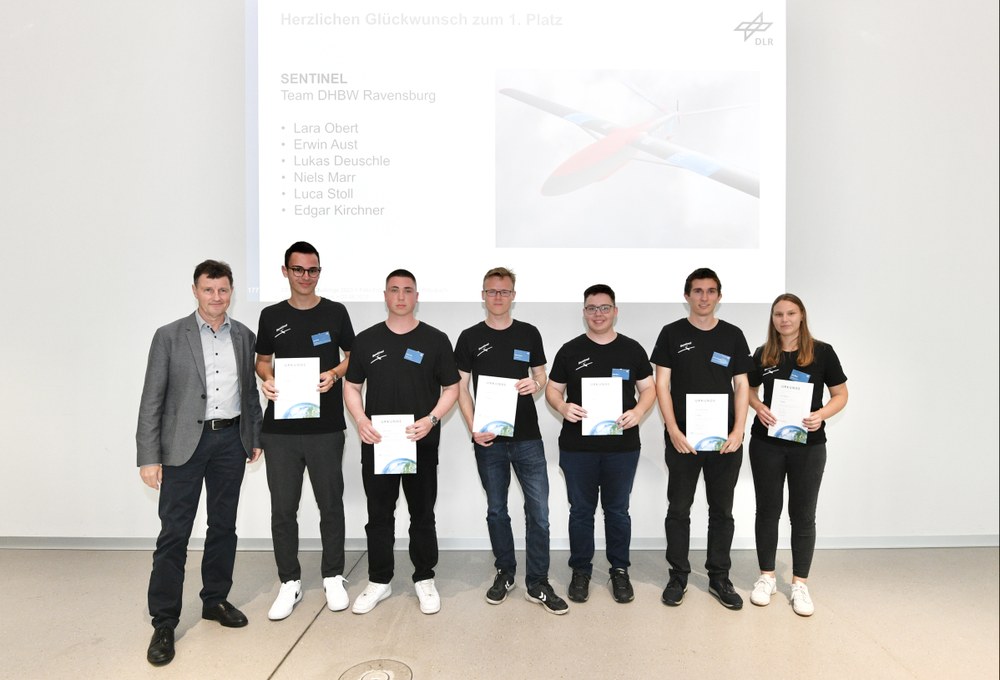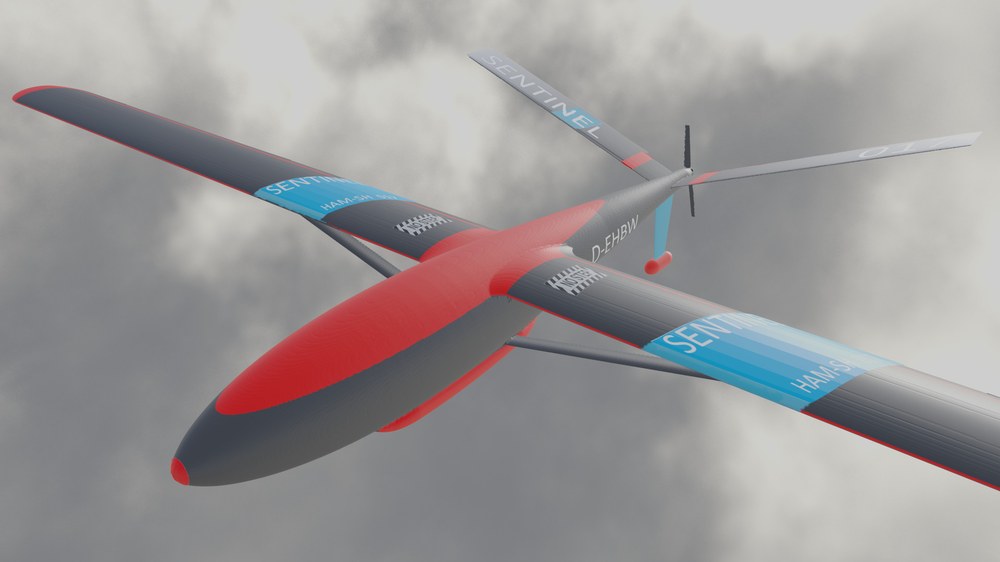Students design aircraft to restore internet connectivity during emergencies


- Students from DHBW Ravensburg convinced the DLR jury with their concept for 'The Sentinel System'.
- The task of the DLR Design Challenge 2023 was to design an airborne system to re-establish internet connectivity.
- Focus: Aeronautics, young researchers, digitalisation
For this year's German Aerospace Center (Deutsches Zentrum für Luft- und Raumfahrt; DLR) Design Challenge, the jury awarded first place to Duale Hochschule Baden-Württemberg (DHBW) Ravensburg's concept for 'The Sentinel System'. Due to climate change, the risk of natural disasters, which can result in a breakdown of the communications infrastructure on the ground, is currently increasing all over the world. The task of the DLR Design Challenge 2023 addressed this topic and required the design of an airborne system to restore internet connectivity. Five student teams presented their designs at the final symposium of the competition in early August 2023. This year's Design Challenge was hosted by the DLR Institute of System Architectures in Aeronautics in Hamburg and the DLR Institute of Aerodynamics and Flow Technology in Braunschweig.
The DHBW team was able to present a very robust design, which can be used all year round and even in the most adverse conditions. According to the jury, decisions made during the design process were rigorously justified to allow for entry into service by 2040. 'The Sentinel System' also incorporates a well-thought-out operational concept to launch a fleet of aircraft as quickly as possible from a purpose-built operational base.
Innovation through diversity
"The DLR Design Challenge shows how innovations can be created with different approaches, diversity and variety," said DLR Executive Board Chair Anke Kaysser-Pyzalla on the occasion of the final of this year's student competition. "The results surprise with a mix of different aerodynamic concepts and propulsion systems for aircraft that can take over tasks as high-altitude platforms in the shortest possible time. All the teams have taken on a major challenge in addition to their regular studies. There are different placings today, but everyone involved has won. Because with your expertise, you have all given thought to the mobility of the future in order to find approaches to solutions for current societal challenges."
Markus Fischer, DLR Divisional Board Member for Aeronautics, added: "Once again this year, the participating teams have brought a very high level of innovation and inventiveness to the task. That alone is a great success. This year's topic was also very well chosen, to design an airborne system that can replace failed internet connectivity in the event of an emergency. On the one hand, it is a very relevant subject, and on the other hand, the designs submitted also reflect the great interest shown by the students."
Restoration of internet connectivity
The task of the Design Challenge was to design an airborne system to restore internet connectivity over a large area for an extended period of time, acting as part of a fleet in a system-of-systems. In addition to securing the communications paths, the airborne system was also required to have the capability of conducting Earth observation of the affected area. Therefore, it was particularly important to combine the requirements for efficiency in continuous operation and rapid operational readiness in the event of a disaster in an aircraft or system design for entry into service by 2040.
The annual Design Challenge took place for the seventh time. After the kick-off event in mid-March at the DLR site in Braunschweig, the students had approximately four months to work on their concepts. The final event took place at DLR's Hamburg site in the ZAL Tech Center at the beginning of August. As a follow-up to the DLR Design Challenge 2023, the three best-placed teams will present their concepts at the German Aerospace Congress (DLRK 2023) in Stuttgart. In addition, the winning team will present its design at the European Aeronautics Science Network International Conference (EASN 2023) in Salerno.
A total of 25 students – in five university teams – successfully participated in the DLR Design Challenge 2023. The three highest-placed winners and the other entries in detail:
First place – DHBW Ravensburg – 'The Sentinel System'
'The Sentinel System' concept from the team at DHBW Ravensburg relies on proven technology and a high-aspect-ratio wing to enable flight durations of up to 50 hours. The aircraft is driven by a 78-kilowatt piston engine, which provides the necessary power for a pusher propeller at the tail. During the design process, special attention was paid to the navigation of the autonomously operated aircraft. Through the consistent implementation of the specially derived design principles, operation is possible even in adverse weather conditions.
The operational concept in an emergency scenario includes a precise timetable for restoring communications as soon as possible, as well as a detailed design of the base of operations.
Team: Lara Obert, Erwin Aust, Lukas Deuschle, Niels Marr, Luca Stoll, Edgar Kirchner
Second place – University of Stuttgart – PERSEUS

The concept submitted by the University of Stuttgart, Post-Emergency Response and Surveillances UAV System (PERSEUS), is an uncrewed blended-wing-body design with a canard. The configuration features a hybrid propulsion system consisting of hydrogen fuel cells, batteries and supercapacitors. This ensures sustainable operation of the system. It is powered by 22 Electric Ducted Fans (EDFs) mounted on the control surfaces. This enables PERSEUS to take off and land vertically using these, in conjunction with an operational concept that uses foldable shipping containers as launch platforms. This makes the system independent of the availability of a runway.
Team: Abhishek Anil, Alexander Hennemann, Hellen Kimmel, Christian Mayer, Lukas Müller, Tobias Reischl
Third place – RWTH Aachen University – HEIKE

RWTH Aachen University's High-Flying, Efficient and Intelligent Crisis Communication Unit (HEIKE) is a next-generation solar-powered aircraft. A canard configuration with landing gear integrated in the inverted V-tail was selected. The high-wing design prevents shadowing of the solar cells on the main wing. During the day, these charge a battery with a capacity of 56 kilowatt hours. In addition, HEIKE can leave its operational flight altitude of 20 kilometres during the day and climb to 25 kilometres in order to store solar energy as potential energy. This energy is released at night during gliding flight with the propeller folded, which should enable the aircraft to be operated for long periods. HEIKE achieves the necessary high aerodynamic efficiency through morphing flaps and a long wingspan of 40 metres. Gust loads will be actively reduced with the help of a lidar system. To allow operational flexibility, HEIKE can be dismantled and transported in a 40-foot container.
Team: Lars Neveling, Johannes Götz, Sebastian Dominik, Sami Zoghlami
Fourth place – TU Dresden – AirLive

The Air Located Internet Vehicle for Emergencies (AirLive) developed by the team at TU Dresden achieves exceptional aerodynamic efficiency when flying at high altitudes thanks to its box-wing configuration. The tanks installed as wing spars supply gaseous hydrogen to the fuel cell, which in turn supplies the electric motors. These drive three propellers that bring the aircraft to its operating altitude of 20 kilometres after a winch launch to reduce the take-off distance. To maintain ground clearance, the wing-mounted propellers are switched off during take-off and landing.
Depending on the mission, AirLive can be adapted to meet the specific requirements by means of a modular design. While the main part of the mission is fully autonomous, with the aircraft communicating with one another, take-offs and landings are remotely controlled by a pilot.
Team: Karl Kühmstedt, Felix Herrmann, Martin Pirags, Thijs Daenen, Tobias Garsoffke
Fifth place – Trier University of Applied Sciences – Prometheus

The concept submitted by the team from Trier University of Applied Sciences, Prometheus, is an uncrewed system with a conventional kite configuration. The system has an electric power train consisting of batteries and a solar array mounted on the wings. Propulsion is generated by two propellers mounted on the wings. In addition to the wings, this concept also generates the required lift using the fuselage, which was specially designed as a lifting body.
Team: Milan Lieser, Fabian Brust, Michael Scheidt, Elisa Kühr

